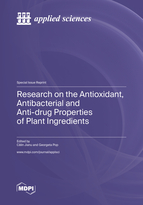Research on the Antioxidant, Antibacterial and Anti-drug Properties of Plant Ingredients
A special issue of Applied Sciences (ISSN 2076-3417). This special issue belongs to the section "Food Science and Technology".
Deadline for manuscript submissions: closed (10 November 2022) | Viewed by 36389
Special Issue Editors
Interests: food safety and hygiene; food additives; food preservation; food waste management; essential oil; design and synthesis of materials
Special Issues, Collections and Topics in MDPI journals
Interests: medicinal and aromatic plants; crop science; antimicrobial activity of essential oils
Special Issue Information
Dear Colleagues,
Food spoilage results mainly when microbiological and chemical changes occur, making food products unacceptable by consumers. Various techniques, such as high-pressure processing, pulsed electric field, modified atmosphere packaging, have been studied to prolong the life shelf of the foodstuff, including the use of natural extracts and essential oils. Natural extracts and essential oils have recently been studied against resistant pathogenic microorganisms whose higher resistance to conventional drugs represents a dramatic problem for human health and healthcare. It has been shown that their supplementation protected the sensory properties of foods, contributes significantly to increasing shelf life, and decrease food waste. Furthermore, their supplementation can reduce cellular oxidative stress, typical of cardiovascular, inflammatory, and neurodegenerative diseases, and certain types of cancer.
Consequently, due to such a vast repertory of beneficial outcomes, natural extracts and essential oils are always fascinating to research fields. Also, it must be considered that agricultural by-products and waste products can also represent a precious source of antioxidants and preservatives.
We warmly encourage you to submit your investigation findings to this Special Issue, which intends to collect original research manuscripts, systematic reviews, and meta-analyses covering all aspects of natural antioxidants and antibacterial applications and properties and health effects.
We look forward to your contribution.
Prof. Dr. Ionel Calin Jianu
Prof. Dr. Georgeta Pop
Guest Editors
Manuscript Submission Information
Manuscripts should be submitted online at www.mdpi.com by registering and logging in to this website. Once you are registered, click here to go to the submission form. Manuscripts can be submitted until the deadline. All submissions that pass pre-check are peer-reviewed. Accepted papers will be published continuously in the journal (as soon as accepted) and will be listed together on the special issue website. Research articles, review articles as well as short communications are invited. For planned papers, a title and short abstract (about 100 words) can be sent to the Editorial Office for announcement on this website.
Submitted manuscripts should not have been published previously, nor be under consideration for publication elsewhere (except conference proceedings papers). All manuscripts are thoroughly refereed through a single-blind peer-review process. A guide for authors and other relevant information for submission of manuscripts is available on the Instructions for Authors page. Applied Sciences is an international peer-reviewed open access semimonthly journal published by MDPI.
Please visit the Instructions for Authors page before submitting a manuscript. The Article Processing Charge (APC) for publication in this open access journal is 2400 CHF (Swiss Francs). Submitted papers should be well formatted and use good English. Authors may use MDPI's English editing service prior to publication or during author revisions.
Keywords
- antioxidant activity
- antibacterial activity
- plant extracts
- essential oils
- synergistic interactions
- polyphenols
- biofilms
- radical scavenging
- shelf life
- waste products







